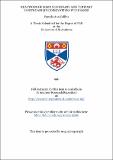Reactions of some secondary and tertiary o-nitroaniline derivatives with bases
Abstract
In chapter 1, a brief account of the chemical and physical properties of benzimidazole A-oxides is given. The scope and limitations of a method recently developed for the synthesis of the N-oxides from substituted o-nitroaniline derivatives are discussed. Chapter 2 discusses the reactions in the literature which are relevant to those being investigated. Chapter 3 describes the efforts made to investigate the involvement of the activatuig' groups of the o-nitroaniline derivatives in the reaction pathway. In chapter 4 the reactions of N-(4 and/or 6-substituted o-nitrophenyl) glycine and sarcosine esters with bases are described. All of the 4-substituted glycine esters and those with fluorine, acetamido and methyl on C-6 cyclized 'normally' to the corresponding NH-benzimidazole N'-oxides whereas those with chlorine, trifluoromethyl, and nitro on C-6 reacted 'abnormally' to give, in addition, such products as 1-hydroxy-quinoxaline-2,3-diones and diaminoazoxybenzenes. All of the sarcosine esters reacted 'abnormally' producing none of the N-methylbenzimidazole N'-oxides. Surprisingly they did form products indicating loss of the W-methyl group, e.g. quinoxalin-2-ones. The aldol-type condensation mechanism that has been previously applied to the syntheses of benzimidazole N-oxides does not explain these new results; they suggest that the presence of an amino-hydrogen in the starting material is necessary for N-oxide formation. An alternative mechanism is proposed which takes this possibility and the types of products formed into account. It involves the formation of an oxadiazine intermediate which can then react in a number of different ways to give the observed products. The reasons for some neighbouring substituents affecting the reaction pathway appears to be largely steric though there may also be an electronic factor. Chapter 5 contains a discussion of how the alternative mechanism could be applied to a number of other cyclizations of carbocyclic and heterocyclic compounds which involve interaction of a nitro group with a potentially nucleophilic ortho-substituent.
Type
Thesis, PhD Doctor of Philosophy
Collections
Items in the St Andrews Research Repository are protected by copyright, with all rights reserved, unless otherwise indicated.

